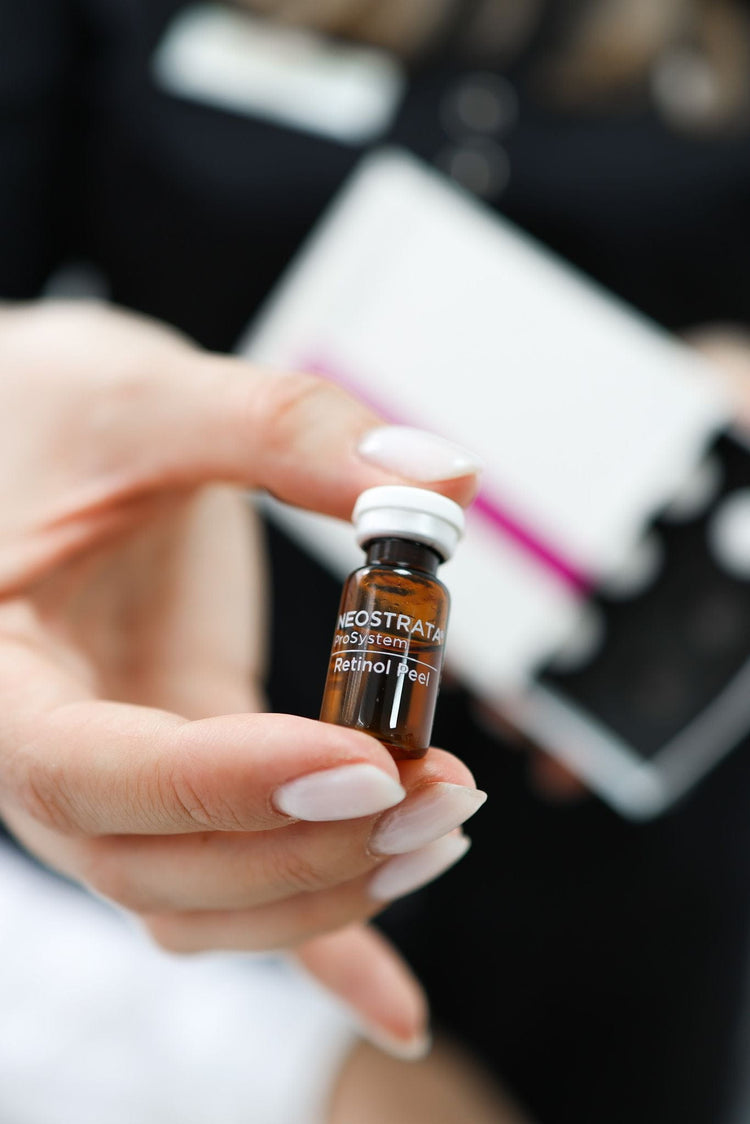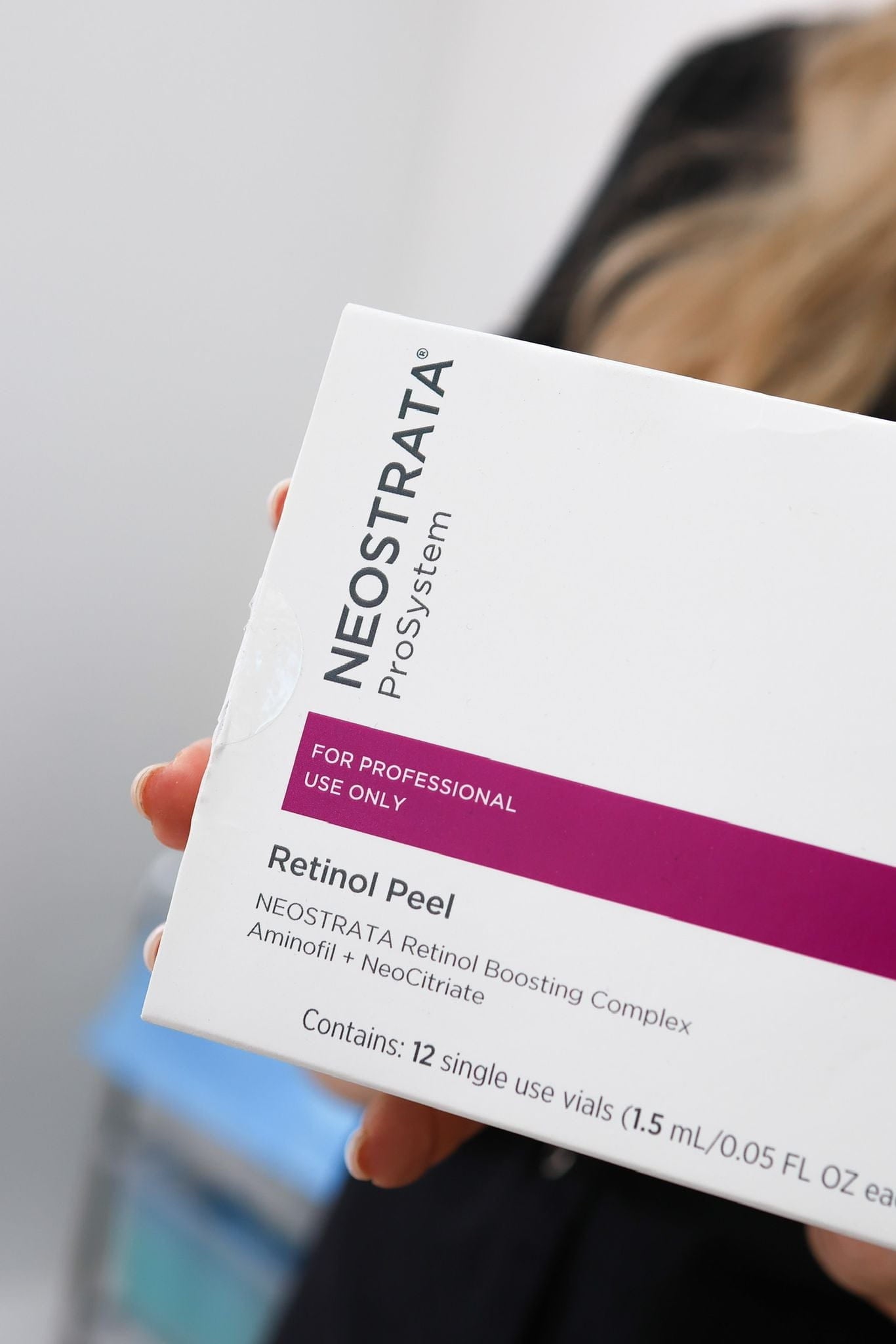Understanding Retinol Peels
Retinol peels have gained significant popularity as a skincare treatment for addressing concerns like fine lines, wrinkles, and acne. However, understanding their potential risks and benefits is crucial before undergoing this procedure. This article delves into the safety of retinol peels specifically in Kingston Upon Thames, exploring factors such as clinic qualifications, individual skin types, and potential side effects to help individuals make informed decisions about incorporating retinol peels into their skincare routine.
What is a Retinol Peel?
Retinol peels utilize a chemical solution containing varying concentrations of retinol, a derivative of vitamin A. This peel works by exfoliating the outermost layer of skin, revealing smoother, brighter skin underneath. It stimulates collagen production, reduces the appearance of fine lines and wrinkles, minimizes pores, and helps to treat acne.
It is essential to consult with a qualified dermatologist or skincare professional in Kingston Upon Thames to determine if a retinol peel is suitable for your specific skin type and concerns. They will assess your skin’s condition, medical history, and any existing medications to ensure the treatment is safe and appropriate.
Types of Retinol Peels
Retinol peels are becoming increasingly popular for addressing various skin concerns, but it’s crucial to understand their different types before opting for one. There are primarily two types of retinol peels: superficial and medium-depth.
Superficial retinol peels use low concentrations of retinol and only affect the epidermis (outer layer of skin). These peels are generally less intense and have a shorter recovery time, making them suitable for individuals with mild skin concerns or sensitive skin. Medium-depth retinol peels utilize higher concentrations of retinol and penetrate deeper into the dermis (middle layer of skin). They are more potent and can address deeper wrinkles, acne scars, and pigmentation issues, but they may require longer downtime for healing.
Benefits of Retinol Peels
Retinol peels offer numerous benefits for skin health. By exfoliating the top layers of skin, they reveal a brighter, smoother complexion. The increased cell turnover also stimulates collagen production, leading to reduced fine lines and wrinkles. Retinol’s anti-inflammatory properties can help manage acne by minimizing inflammation and unclogging pores.
Additionally, retinol peels can improve skin texture by reducing the appearance of enlarged pores. They can also address hyperpigmentation by fading dark spots and promoting a more even skin tone. It is important to note that individual results may vary depending on factors such as skin type and the severity of skin concerns.
Safety Considerations for Retinol Peels
Before considering a retinol peel, it’s crucial to understand the potential risks and benefits associated with this treatment.
Potential Side Effects
While retinol peels offer numerous benefits for skin health, it is essential to be aware of potential side effects. Common side effects include redness, dryness, flaking, itching, and sensitivity to sunlight. These effects are typically temporary and subside within a few days to a week.
In some cases, more severe side effects may occur, such as blistering, infection, or scarring. These risks are more likely with deeper peels or if the treatment is not performed properly by a qualified professional. It’s crucial to consult with a dermatologist in Kingston Upon Thames to assess your individual risk factors and discuss any concerns you may have.
To minimize potential side effects and ensure optimal results, it’s important to follow pre- and post-treatment instructions provided by your skincare professional. This may include avoiding sun exposure, using sunscreen diligently, and applying prescribed creams or medications.
Contraindications for Retinol Peels
Safety Considerations for Retinol Peels:
Retinol peels are a chemical exfoliation treatment that can improve skin appearance but come with potential risks. It is crucial to choose a qualified dermatologist or skincare professional in Kingston Upon Thames who has experience performing retinol peels and understands your individual skin type and concerns.
Contraindications for Retinol Peels:
Certain individuals should avoid retinol peels due to potential risks. These include people with active acne flare-ups, sensitive skin prone to irritation, those using certain medications like retinoids or antibiotics, pregnant or breastfeeding women, and individuals with a history of skin scarring.
Choosing a Qualified Practitioner
Safety Considerations for Retinol Peels:
Retinol peels are a chemical exfoliation treatment that can improve skin appearance but come with potential risks. It is crucial to choose a qualified dermatologist or skincare professional in Kingston Upon Thames who has experience performing retinol peels and understands your individual skin type and concerns.
- Consultation: Before undergoing a retinol peel, consult with a qualified dermatologist or skincare professional in Kingston Upon Thames. They will assess your skin condition, medical history, and any existing medications to ensure the treatment is safe and appropriate for you.
- Skin Type: Different skin types react differently to retinol peels. Individuals with sensitive skin may experience more pronounced side effects. Your chosen practitioner will help determine the appropriate peel strength and frequency based on your skin type.
- Contraindications: Certain individuals should avoid retinol peels due to potential risks. These include people with active acne flare-ups, sensitive skin prone to irritation, those using certain medications like retinoids or antibiotics, pregnant or breastfeeding women, and individuals with a history of skin scarring.
- Post-Treatment Care: Following pre- and post-treatment instructions provided by your skincare professional is crucial for minimizing side effects and ensuring optimal results. This may include avoiding sun exposure, using sunscreen diligently, and applying prescribed creams or medications.
Choosing a Qualified Practitioner
Selecting a qualified and experienced practitioner is paramount for safe and effective retinol peels in Kingston Upon Thames. Look for practitioners who are licensed dermatologists, registered nurses with specialized training in chemical peels, or certified estheticians with extensive experience in this procedure.

- Qualifications: Ensure the practitioner holds relevant licenses and certifications related to skincare and chemical peels.
- Experience: Inquire about their experience performing retinol peels specifically and their success rates.
- Cleanliness: The clinic should maintain high standards of hygiene and sterilization to minimize infection risks.
By taking these precautions and choosing a qualified practitioner, you can maximize the potential benefits of retinol peels while minimizing risks associated with this treatment.
Retinol Peels in Kingston Upon Thames
Retinol peels have become increasingly popular in Kingston Upon Thames for addressing skin concerns like wrinkles, acne, and uneven skin tone. These peels utilize a chemical solution containing varying concentrations of retinol, a derivative of vitamin A, to exfoliate the skin and reveal a brighter, smoother complexion. However, it’s crucial to understand the potential risks and benefits before undergoing this procedure.
Finding a Reputable Clinic
Finding a reputable clinic for retinol peels in Kingston Upon Thames involves careful research and consideration. Begin by seeking recommendations from friends or family who have experience with cosmetic treatments. Online reviews on platforms like Google or Yelp can offer insights into the experiences of other patients.
It’s essential to look beyond superficial factors like price and aesthetics. Investigate the clinic’s qualifications, experience, and safety protocols. Ensure the practitioners are licensed dermatologists, registered nurses with specialized training in chemical peels, or certified estheticians with extensive experience performing retinol peels.
Schedule consultations with multiple clinics to assess their approach to treatment, understand their expertise in retinol peels, and discuss your specific skin concerns and goals. Don’t hesitate to ask questions about their qualifications, sterilization practices, post-treatment care instructions, and any potential risks or side effects associated with the procedure.
Prioritize clinics that prioritize patient safety, transparency, and individualized treatment plans. Remember, your skin health is paramount, so investing time in finding a trustworthy and skilled practitioner is crucial for achieving desired results while minimizing potential risks.
Cost of Retinol Peels in Kingston Upon Thames
Retinol peels are becoming increasingly popular for addressing various skin concerns, but it’s crucial to understand their different types before opting for one. There are primarily two types of retinol peels: superficial and medium-depth.
Superficial retinol peels use low concentrations of retinol and only affect the epidermis (outer layer of skin). These peels are generally less intense and have a shorter recovery time, making them suitable for individuals with mild skin concerns or sensitive skin. Medium-depth retinol peels utilize higher concentrations of retinol and penetrate deeper into the dermis (middle layer of skin). They are more potent and can address deeper wrinkles, acne scars, and pigmentation issues, but they may require longer downtime for healing.
Retinol peels offer numerous benefits for skin health. By exfoliating the top layers of skin, they reveal a brighter, smoother complexion. The increased cell turnover also stimulates collagen production, leading to reduced fine lines and wrinkles. Retinol’s anti-inflammatory properties can help manage acne by minimizing inflammation and unclogging pores.
Additionally, retinol peels can improve skin texture by reducing the appearance of enlarged pores. They can also address hyperpigmentation by fading dark spots and promoting a more even skin tone. It is important to note that individual results may vary depending on factors such as skin type and the severity of skin concerns.
Before considering a retinol peel, it’s crucial to understand the potential risks and benefits associated with this treatment.
While retinol peels offer numerous benefits for skin health, it is essential to be aware of potential side effects. Common side effects include redness, dryness, flaking, itching, and sensitivity to sunlight. These effects are typically temporary and subside within a few days to a week.
In some cases, more severe side effects may occur, such as blistering, infection, or scarring. These risks are more likely with deeper peels or if the treatment is not performed properly by a qualified professional. It’s crucial to consult with a dermatologist in Kingston Upon Thames to assess your individual risk factors and discuss any concerns you may have.
To minimize potential side effects and ensure optimal results, it’s important to follow pre- and post-treatment instructions provided by your skincare professional. This may include avoiding sun exposure, using sunscreen diligently, and applying prescribed creams or medications.
- Consultation: Before undergoing a retinol peel, consult with a qualified dermatologist or skincare professional in Kingston Upon Thames. They will assess your skin condition, medical history, and any existing medications to ensure the treatment is safe and appropriate for you.
- Skin Type: Different skin types react differently to retinol peels. Individuals with sensitive skin may experience more pronounced side effects. Your chosen practitioner will help determine the appropriate peel strength and frequency based on your skin type.
- Contraindications: Certain individuals should avoid retinol peels due to potential risks. These include people with active acne flare-ups, sensitive skin prone to irritation, those using certain medications like retinoids or antibiotics, pregnant or breastfeeding women, and individuals with a history of skin scarring.
- Post-Treatment Care: Following pre- and post-treatment instructions provided by your skincare professional is crucial for minimizing side effects and ensuring optimal results. This may include avoiding sun exposure, using sunscreen diligently, and applying prescribed creams or medications.
Choosing a Qualified Practitioner
Selecting a qualified and experienced practitioner is paramount for safe and effective retinol peels in Kingston Upon Thames. Look for practitioners who are licensed dermatologists, registered nurses with specialized training in chemical peels, or certified estheticians with extensive experience in this procedure.

- Qualifications: Ensure the practitioner holds relevant licenses and certifications related to skincare and chemical peels.
- Experience: Inquire about their experience performing retinol peels specifically and their success rates.
- Cleanliness: The clinic should maintain high standards of hygiene and sterilization to minimize infection risks.
By taking these precautions and choosing a qualified practitioner, you can maximize the potential benefits of retinol peels while minimizing risks associated with this treatment.
The cost of retinol peels in Kingston Upon Thames can vary depending on factors like the depth of the peel, the size of the area treated, and the experience of the practitioner. It is best to consult with several clinics in Kingston Upon Thames to obtain personalized quotes based on your specific needs.
Reviews and Testimonials
Retinol peels are a popular skincare treatment in Kingston Upon Thames for addressing concerns like fine lines, wrinkles, acne, and uneven skin tone. While they offer potential benefits such as smoother, brighter skin and reduced pigmentation, it’s important to understand the risks and choose a qualified practitioner.
When considering retinol peels, research clinics thoroughly. Look for positive reviews and testimonials from past patients. Websites like Google Reviews and Yelp can offer insights into client experiences and practitioner expertise.
Don’t solely rely on price as an indicator of quality. Focus on the practitioner’s qualifications, experience with retinol peels, and commitment to safety protocols. A consultation allows you to ask questions, discuss your skin concerns, and determine if a retinol peel is appropriate for you.
Post-Peel Care and Maintenance
Post-peel care involves diligently following instructions from your skincare professional. This often includes avoiding sun exposure, applying sunscreen frequently, and using prescribed creams or medications to soothe and protect the healing skin. Consistent care during this period is crucial for minimizing irritation, promoting optimal healing, and achieving desired results.
Recovery Time
Post-peel care is essential for successful recovery and optimal results from a retinol peel.
Here are some key steps involved:
* **Protect your skin from the sun:** Avoid direct sunlight and UV exposure as much as possible during the healing period, as retinol can make your skin more susceptible to sunburn. Apply broad-spectrum sunscreen with an SPF of 30 or higher liberally and frequently throughout the day.
* **Keep your skin hydrated:** Use gentle, fragrance-free moisturizers to keep your skin hydrated and prevent dryness, which can lead to flaking and irritation. Follow your practitioner’s recommendations for specific products to use.
* **Avoid harsh skincare products:** Steer clear of exfoliants, retinoids, or other potentially irritating products during the recovery period as they can damage the delicate skin.
* **Be gentle with cleansing:** Wash your face gently twice a day with lukewarm water and a mild cleanser recommended by your practitioner. Avoid scrubbing or using abrasive cloths.
* **Apply prescribed medications:** If your practitioner has prescribed any creams, ointments, or other medications, apply them as directed to support healing and minimize side effects.
* **Monitor for any adverse reactions:** Keep an eye out for signs of infection such as redness, swelling, or pus discharge. If you experience any concerning symptoms, contact your practitioner immediately.
The recovery time for retinol peels varies depending on the depth of the peel and individual skin response. Generally, superficial peels may have a shorter downtime of a few days to a week, while medium-depth peels can require 7-14 days or longer for full healing.
Aftercare Instructions
Post-peel care is crucial for optimal results and recovery after a retinol peel. Here’s what you need to know:
* **Sun Protection:** Your skin will be more sensitive to the sun, so diligent sun protection is essential. Avoid direct sunlight and wear broad-spectrum sunscreen with an SPF of 30 or higher every day, even on cloudy days. Reapply sunscreen every two hours, especially after sweating or swimming.
* **Hydration:** Keep your skin hydrated by using a gentle, fragrance-free moisturizer recommended by your practitioner. Avoid harsh soaps or cleansers that can strip the skin of its natural oils.
* **Gentle Cleansing:** Wash your face twice daily with lukewarm water and a mild cleanser. Avoid scrubbing or using abrasive cloths, as this can irritate the sensitive skin.
* **Avoid Irritants:** Steer clear of exfoliating scrubs, retinol products, and other harsh chemicals during the healing period. These can cause further irritation and delay recovery.
* **Follow Instructions:** Adhere strictly to any post-peel instructions provided by your skincare professional. This may include specific medications or creams to apply, as well as guidelines for activities like exercise and makeup use.
* **Monitor for Side Effects:** Be aware of potential side effects like redness, dryness, flaking, or itching. Most side effects are temporary and subside within a few days to a week. However, if you experience any severe or persistent symptoms, contact your practitioner immediately.
Remember, patience is key during the recovery process.
Allow your skin time to heal properly, and avoid rushing back to your normal skincare routine too soon.
Maintaining Results
Post-peel care is crucial for optimal healing and achieving the desired results from a retinol peel.
Here are some essential tips for post-peel care:
- Sun Protection is Paramount: Your skin will be more sensitive to the sun after a retinol peel, so protecting it from UV rays is vital. Apply broad-spectrum sunscreen with an SPF of 30 or higher liberally and frequently throughout the day, even on cloudy days.
- Hydrate, Hydrate, Hydrate: Keep your skin well moisturized by using a gentle, fragrance-free moisturizer recommended by your practitioner. Avoid products containing alcohol or fragrances that can irritate freshly exfoliated skin.
- Gentle Cleansing is Key: Wash your face twice daily with lukewarm water and a mild cleanser as instructed by your practitioner. Avoid scrubbing or using harsh cloths that could further irritate the skin.
- Avoid Irritants: Steer clear of any skincare products that may be irritating to sensitive skin, such as exfoliants, retinoids, or products containing alcohol or fragrances.
- **Follow Instructions Carefully: **Adhere strictly to all post-peel instructions provided by your skincare professional. This may include specific medications to apply, guidelines for makeup use, and recommendations for activities like exercise and sun exposure.
- Monitor for Side Effects: Pay attention to any changes in your skin’s appearance. If you experience any signs of infection (redness, swelling, pus), or discomfort that worsens, contact your practitioner immediately.
Remember, patience is essential during the healing process. It takes time for the skin to regenerate and achieve optimal results from a retinol peel. By following these post-peel care instructions diligently, you can minimize potential complications, support healing, and maximize the benefits of this treatment.
- Who Shouldn’t Get Lip Fillers? - November 8, 2025
- What Is Sexual Liberation And How Does It Challenge Conventional Relationships? - November 6, 2025
- Weed Infused Beverages That Won’t Break The Bank - November 3, 2025

